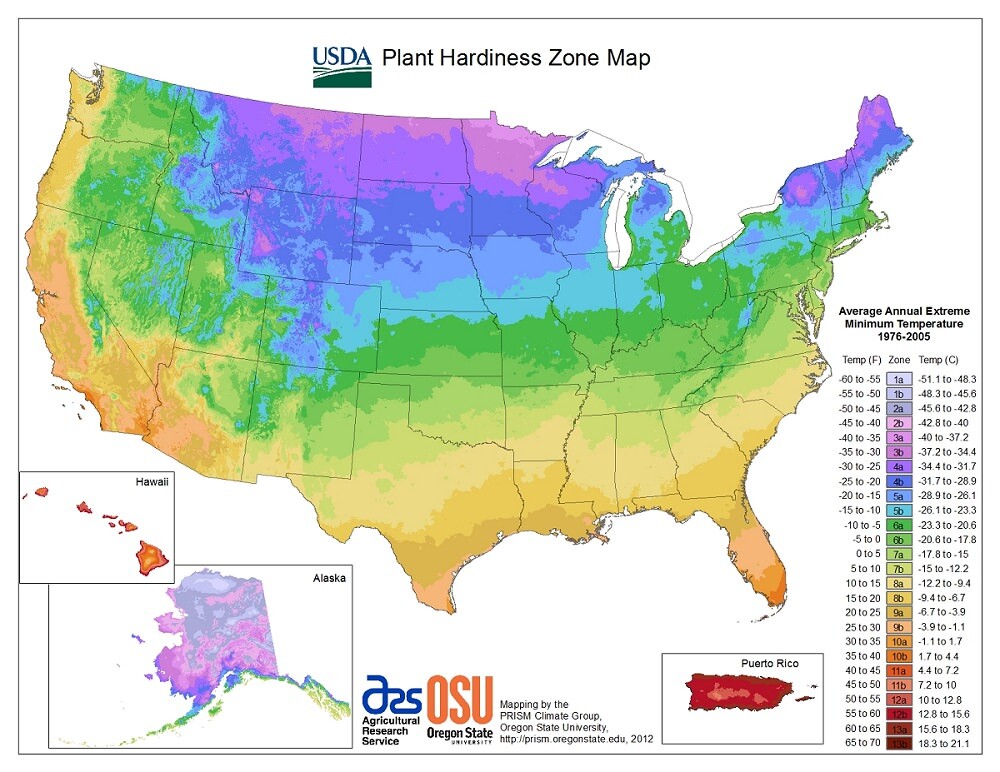Understanding Your Climate Zone

Cold Temperature Zones:
The USDA Plant Hardiness Zone Map was created by the USDA to help farmers and gardeners understand which plants are most likely to thrive in a specific location. The map is based on the average annual minimum winter temperature, divided into zones. Hardiness zones are based on the average annual extreme minimum temperature during a 30-year period. Keep this in mind when selecting plants for your greenhouse. Though not recommended for outdoor growing, it's possible to grow healthy plants outside of your hardiness zone because zone temperatures are not concrete. Greenhouse growing will extend your options, as a greenhouse will give you control over temperature, lighting conditions, and more. Visit https://planthardiness.ars.usda.gov/PHZMWeb/ and enter your zip code to determine your hardiness zone.
Hot Temperature Zones:
The American Horticultural Society created a Plant Heat Zone Map that is similar to the hardiness map, except it creates zones based on high temperatures. This map indicates which plants will survive the changing seasons or "over-winter." Most plants begin to feel distressed at 86 degrees Fahrenheit. The map below calculates how many average days per year a region has temperatures higher than 86. Greenhouse cooling strategies, shade cloth, and proper air circulation within a greenhouse can help mitigate the heat to give you the best blooms. To view the map and learn more information, visit https://www.ahsgardening.org/gardening-resources/gardening-maps/heat-zone-map.
Sunset Climate Zone Map:
The Sunset Climate Zone Map takes into account length of growing season, timing and amount of rainfall, winter lows, summer highs, wind, and humidity. The Sunset Climate Zone Map considers temperature (where plants will thrive year-round vs. just winter or summer), latitude, elevation, ocean influence, continental air influence, and microclimates. These regionally specific maps will show you the growing season, average high and low temperatures, rainfall and humidity in your zone. Leaning the natural weather influences in your area can greatly help with both outdoor and greenhouse growing. You can search for your zone at https://www.sunset.com/garden/climate-zones/sunset-climate-zones.
Which Plants Can I Grow?
Most plants and flowers in garden centers and nurseries have been categorized based on the USDA and AHS research. On each plant, there will be four numbers. For example, a tulip may be 3-8, 8-1, meaning that USDA zones 3 through 8, and AHS zones 8 through 1 are recommended areas for outdoor cultivation. If you live in USDA Zone 7 and AHS Zone 7, you can leave tulips outdoors in your garden year-round. A quick internet search will give you a full list of plants that will naturally thrive in your zone based on all three maps. Your greenhouse can help keep plans safe from heat or cold that is outside of their recommended parameters.
Extend your growing season:
While knowing which plants will thrive in your zone is helpful, owning a greenhouse can extend your garden well past the parameters of governmental recommendations. Whether you are a beginning gardener, a prize-winning hobbyist or a commercial grower, a controlled greenhouse environment will help protect your plants from extremes of climate, unpredictable weather patterns, and short growing seasons. Call Gothic Arch Greenhouses at 1-800-531-4769 to talk with one of our specialists about a greenhouse that's right for you.
